honda motorcycle workshop manual CBR series
The Honda CBR brands become a series of Honda recreation bikes.
The CBR125 was introduced in 2004 by Honda to fill out a space when you look at the 125 cc marketplace left because of the stopped Honda NSR125.2004 to 2006
The
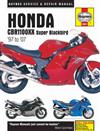
Hardcover - 304 pages - Honda CBR1100XX Super Blackbird 1997 -2007 Haynes Owners Service Repair Manual covers the following models: Honda CBR1100XX-V 1997 Honda CBR1100XX-W 1998 Honda CBR1100XX-X 1999 Honda CBR1100XX-Y 2000 Honda CBR1100XX-1 2001 Honda CBR1100XX-2 2002 Honda CBR1100XX-3 2003 Honda CBR1100XX-4 2004 Honda CBR1100XX-5 2005 Honda CBR1100XX-6 2006 - 2007Contents: Honda CBR1100XX Super Blackbird Maintenance- Routine Maintenance And Servicing- Specifications- Lubricants And Fluids- Maintenance Schedule- Component Locations- Maintenance Procedures Repairs Overhaul- Engine Clutch And Transmission- Fuel And Exhaust Systems- Ignition System- Frame And Suspension- Brakes Wheels And Final Drive- Fairing And Bodywork- Electrical System- Wiring Diagrams Reference- Tools And Workshop Tips- Security- Storage- Troubleshooting
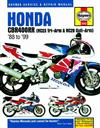
Hardcover - 272 pages - Honda CBR400RR Fours 1988 - 1999 Haynes Owners Service Repair Manual Covers the following Models: Honda CBR400RR NC23 Tri-Arm (J and K) 1988 - 1999 Honda CBR400RR NC29 Gull-Arm 1990 - 1999 Honda CBR400RR Fireblade (L N and R) 1990 - 1999Contents: Honda CBR400RR Motorcycle Maintenance- Routine Maintenance And Servicing- Specifications- Lubricants And Fluids- Maintenance Schedule- Component Locations- Maintenance Procedures Repairs And Overhaul- Engine Clutch And Transmission- Fuel And Exhaust Systems- Ignition System- Frame And Suspension- Brakes Wheels And Final Drive- Fairing And Bodywork- Electrical System- Wiring Diagrams Reference- Tools And Workshop Tips- Security- Storage- Troubleshooting
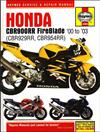
Hardcover - 288 pages. - Honda CBR900RR Fireblade CBR929RR CBR954RR 2000 - 2003 Haynes Owners Service Repair Manual Covers the following Models: Honda CBR900RRY 929cc 2000 Honda CBR900RR-1 929cc 2001 Honda CBR900RR-2 954cc 2002 Honda CBR900RR-3 954cc 2003 Honda CBR929RR-Y 929cc 2000 Honda CBR929RR-1 929cc 2001 Honda CBR954RR-2 954cc 2002 Honda CBR954RR-3 954cc 2003Contents: Living With Your HONDA CBR900RR FIREBLADE- Identification Numbers- Buying Spare Parts- Pre-Ride Checks- Engine Oil Level- Brake Fluid Levels- Tyres- Bike Specs Maintenance- Routine Maintenance And Servicing- Specifications- Lubricants And Fluids- Maintenance Schedule- Component Locations- Maintenance Procedures Repairs And Overhaul- Engine Clutch And Transmission- Fuel And Exhaust Systems- Ignition System- Frame And Suspension- Brakes Wheels And Final Drive- Fairing And Bodywork- Electrical System- Wiring Diagrams Reference- Tools And Workshop Tips- Security- Storage- Troubleshooting
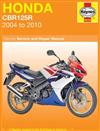
Softcover - 240 pages - Honda CBR125R 2004 - 2010 Haynes Owners Service Repair Manual covers the following Models: CBR125R-4 124cc 2004 CBR125R-5 124cc 2005 CBR125R-6 124cc 2006 CBR125RW-7 124cc 2007 CBR125RW-8 124cc 2008 CBR125RW-9 124cc 2009 CBR125RW-A 124cc 2010Contents: Routine Maintenance and Service Maintenance Schedule Engine Clutch and Transmission Fuel System and Lubrication Ignition System Frame and Suspension Wheels Brakes and Tyres Electrical System Wiring Diagrams Troubleshooting
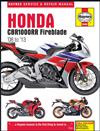
Hardcover - 320 pages - Honda CBR1000RR Fireblade 2008 - 2013 Haynes Owners Service Repair Manual covers the following models: CBR1000RR-8 999cc 2008 CBR1000RR-9/RA-9 999cc 2009 CBR1000RR-A/RA-A 999cc 2010 CBR1000RR-B/RA-B 999cc 2011 CBR1000RR-C/RA-C 999cc 2012 CBR1000RA-D 999cc 2013Contents: Living With Your HONDA CBR1000RR FIREBLADE- Identification Numbers- Buying Spare Parts- Pre-Ride Checks- Engine Oil Level- Brake Fluid Levels- Tyres- Bike Specs Maintenance- Routine Maintenance And Servicing- Specifications- Lubricants And Fluids- Maintenance Schedule- Component Locations- Maintenance Procedures Repairs And Overhaul- Engine Clutch And Transmission- Fuel And Exhaust Systems- Ignition System- Frame And Suspension- Brakes Wheels And Final Drive- Fairing And Bodywork- Electrical System- Wiring Diagrams Reference- Tools And Workshop Tips- Security- Storage- Troubleshooting
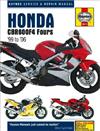
Hardcover - 304 pages - Honda CBR600F4 Fours 1999 - 2002 Haynes Owners Service Repair Manual Covers the following Models: Honda CBR600F-X 1999 Honda CBR600F-Y 2000 Honda CBR600F-1 CBR600FS-1 Sport 2001 Honda CBR600F-2 CBR600FS-2 Sport 2002 Honda CBR600F-3 2003 Honda CBR600F-4 2004 Honda CBR600F-5 2005 Honda CBR600F-6 2006Table of Contents Living With Your Honda CBR600F4- Identification Numbers- Engine Oil Level- Brake Fluid Levels- Tyres- Bike Specs Maintenance- Routine Maintenance And Servicing- Specifications- Lubricants And Fluids- Maintenance Schedule- Component Locations- Maintenance Procedures Repairs Overhaul- Engine Clutch And Transmission- Fuel And Exhaust Systems- Ignition System- Frame And Suspension- Brakes Wheels And Final D
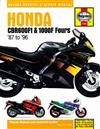
Hardcover - 224 pages - Honda CBR600F1 1000F Fours 1987 - 1996 Haynes Owners Service Repair Manual covers the following Models: CBR600F-H 598cc 1987 CBR600F-J 598cc 1988 CBR600F-K 598cc 1989 CBR600F-L 598cc 1990 CBR1000F-H 998cc 1987 CBR1000F-J 998cc 1988 CBR1000F-K 998cc 1989 CBR1000F-L 998cc 1990 CBR1000F-M 998cc 1991 CBR1000F-N 998cc 1992 CBR1000F-P 998cc 1993 CBR1000F-R 998cc 1994 CBR1000F-S 998cc 1995 CBR1000F-T 998cc 1996.Please refer to manual number HM2070 for the 599cc CBR600F2 and F3. models.Contents: Living With Your Honda CBR600F1 CBR1000F HURRICANE- Identification Numbers- Buying Spare Parts- Pre-Ride Checks- Engine Oil Level- Brake Fluid Levels- Tyres- Bike Specs Maintenance- Routine Maintenance And Servicing- Specifications- Lubricants And Fluids- Maintenance Schedule- Component Locations- Maintenance Procedures Repai
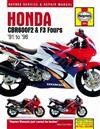
Hardcover - 256 pages - Honda CBR600F2 F3 Fours 1991 - 1998 Haynes Owners Service Repair Manual Covers the following Models: CBR600F-M 599cc 1991 CBR600F-N 599cc 1992 CBR600F-P 599cc 1993 CBR600F-R 599cc 1994 CBR600F-S 599cc 1995 CBR600F-T 599cc 1996 CBR600F-V 599cc 1997 CBR600F-W 599cc 1998Contents Honda CBR600F2 CBR600F3 Sportbike Maintenance- Routine Maintenance And Servicing- Specifications- Lubricants And Fluids- Maintenance Schedule- Component Locations- Maintenance Procedures Repairs And Overhaul- Engine Clutch And Transmission- Fuel And Exhaust Systems- Ignition System- Frame And Suspension- Brakes Wheels And Final Drive- Fairing And Bodywork- Electrical System- Wiring Diagrams Reference- Tools And Workshop Tips- Security- Storage- Troubleshooting
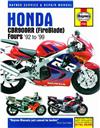
Hardcover - 232 pages - Honda CBR900RR FireBlade Fours 1992 - 1999 Haynes Owners Service Repair Manual Covers the following Models: Honda CBR900RR-N 893cc 1992 Honda CBR900RR-P 893cc 1993 Honda CBR900RR-R 893cc 1994 Honda CBR900RR-S 893cc 1995 Honda CBR900RR-T 919cc 1996 Honda CBR900RR-V 919cc 1997 Honda CBR900RR-W 919cc 1998 Honda CBR900RR-X 919cc 1999Contents: Living With Your Honda Fireblade CBR900RR- Identification Numbers- Buying Spare Parts- Pre-Ride Checks- Engine Oil Level- Brake Fluid Levels- Tyres- Bike Specs Maintenance- Routine Maintenance And Servicing- Specifications- Lubricants And Fluids- Maintenance Schedule- Component Locations- Maintenance Procedures Repairs And Overhaul- Engine Clutch And Transmission- Fuel And Exhaust Systems- Ignition System- Frame And Suspension- Brakes Wheels And Final Drive- Fairing And Bodywork- Electrical System- Wiring Diagrams Reference- Tools And Workshop Tips- Security- Storage- Troubleshooting
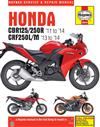
Softcover - 272 pages - Honda CBR125R CBR250R CRF250L/M 2011 - 2014 Haynes Owners Service Repair Manual covers the following models: CBR125R (124.7cc) 2011 - 2014 CBR250R (249.6cc) 2011 - 2014 CBR250RA (249.6cc) 2011 - 2014 CRF250L (249.6cc) 2013 - 2014 CRF250M (249.6cc) 2014Contents: Identification numbers Safety first Pre-ride checks Specifications Routine maintenance and servicing CBR125 - Engine clutch and transmission CBR250 CRF250 - Engine clutch and transmission Cooling system Engine management system Frame and suspension Brakes wheels and final drive Bodywork Electrical system Wiring diagrams Reference
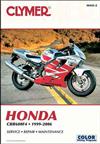
Softcover - 558 pages - Honda CBR600F4 1999 - 2006 Clymer Owners Service Repair Manual Covers the following models: CBR600F4 (1999-2000) CBR600F4i (2001-2006) CBR600F (U.K.) (1999-2000) CBR600F Sport (U.K.) (2001-2006)Contents: QUICK REFERENCE DATA GENERAL INFORMATIONManual organization / Warnings cautions and notes / Safety / Serial numbers / Fasteners / Shop supplies / Basic tools / Precision measuring instruments / Electrical system fundamentals / Special tools / Basic service methods / Storage / Specifications TROUBLESHOOTINGOperating requirements / Starting the engine (carbureted models) / Starting the engine (Fuel injected models / Starting difficulties / Engine performance / Engine noises / Engine lubrication / Cylinder leakdown test / Clutch / Gearshift linkage / Transmission / Fuel system (carbureted models) / Fuel system (fuel injected models) / Electrical troubleshooting / Troubleshooting test equipment / Basic test procedures / Lighting system / Cha
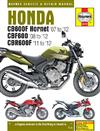
Hardcover - 304 pages - Honda CBR600F Hornet CBF600 CBR600F 2007 - 2012 Haynes Owners Service Repair Manual covers the following models: CB600F Hornet (599cc) 2007 - 2012 CB600FA Hornet (599cc) 2007 - 2012 CBF600N (599cc) 2008 - 2012 CBF600NA (599cc) 2008 - 2012 CBF600S (599cc) 2008 - 2012 CBF600SA (599cc) 2008 - 2012 CBR600F (599cc) 2011 - 2012 CBR600FA (599cc) 2011 - 2012Table of Contents Introduction Pre-Ride Checks Routine Maintenance and Servicing Engine Transmission and Associated Systems Chassis Components Electrical System Wiring Diagrams
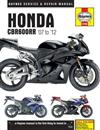
Hardcover: - 320 pages - Honda CBR600RR 2007 - 2012 Haynes Owners Service Repair Manual covers the following models: Honda CBR600RR-7 599cc 2007 Honda CBR600RR-8 599cc 2008 Honda CBR600RR-9 599cc 2009 Honda CBR600RR-A 599cc 2010 Honda CBR600RR-B 599cc 2011 Honda CBR600RR-C 599cc 2012Contents: Living With Your HONDA CBR600RR SPORTBIKE- Identification Numbers- Buying Spare Parts- Pre-Ride Checks- Engine Oil Level- Brake Fluid Levels- Tyres- Bike Specs Maintenance- Routine Maintenance And Servicing- Specifications- Lubricants And Fluids- Maintenance Schedule- Component Locations- Maintenance Procedures Repairs And Overhaul- Engine Clutch And Transmission- Fuel And Exhaust Systems- Ignition System- Fr
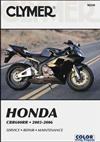
Softcover - 526 pages - Honda CBR600RR 2003 - 2006 Owners Service Repair Manual Covers: Honda CBR600RRContents: QUICK REFERENCE DATA GENERAL INFORMATIONManual organization / Warnings cautions and notes / Safety / Serial numbers / Fasteners / Shop supplies / Tools / Measuring tools / Electrical system fundamentals / Service methods / Storage / Specifications TROUBLESHOOTINGStarting the engine / Engine will not start / Engine performance / Engine removal and installation / Engine lubrication / Cylinder leakdown test / Clutch / Gearshift linkage / Transmission / Fuel system / Electrical testing / Lighting system / Charging system / Ignition system / Starting system / Front suspension and steering / Brake system / Specifications LUBRICATION MAINTENANCE AND TUNE-UPAir filter / Compression test / Spark plugs / Ignition timing / Valve clearance / EFI starter valve s
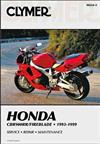
Softcover - 524 pages - Honda CBR900RR Fireblade 1993 - 1999 Service Repair Manual Covers the following Models: CBR900RR (1993-1999) Fireblade (U.K.) (1993-1999)Contents: QUICK REFERENCE DATA GENERAL INFORMATIONManual organization / Warnings cautions and notes / Safety / Serial numbers / Fasteners / Shop supplies / Basic tools / Precision measuring tools / Electrical system fundamentals / Special tools / Basic service methods / Storage /Specifications TROUBLESHOOTINGManual organization / Starting the engine / Starting difficulties / Engine performance / Engine noises / Engine lubrication / Cylinder leakdown test / Clutch / Gearshift linkage / Transmission / Electrical troubleshooting / Test equipment / Basic test procedures / Electrical problems / Charging system / Ignition system troubleshooting / Starter system troubleshooting / Carburetor
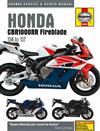
Hardcover - 302 pages - Honda CBR1000RR Fireblade 2004 - 2007 Haynes Owners Service Repair Manual covers the following models: Honda CBR1000RR-4 2004 Honda CBR1000RR-5 2005 Honda CBR1000RR-6 2006 Honda CBR1000RR-7 2007Contents: Living With Your HONDA CBR1000RR FIREBLADE- Identification Numbers- Buying Spare Parts- Pre-Ride Checks- Engine Oil Level- Brake Fluid Levels- Tyres- Bike Specs Maintenance- Routine Maintenance And Servicing- Specifications- Lubricants And Fluids- Maintenance Schedule- Component Locations- Maintenance Procedures Repairs And Overhaul- Engine Clutch And Transmission- Fuel And Exhaust Systems- Ignition System- Frame And Suspension- Brakes Wheels And Final Drive- Fairing And Bodywork- Electrical System- Wiring Diagr
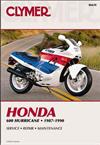
Softcover - 424 pages - Honda Hurricane CBR600 1987 - 1990 Clymer Owners Service Repair Manual covers CBR600F 600 Hurricane (1987-1990).Contents: QUICK REFERENCE DATA GENERAL INFORMATIONManual organization / Notes cautions and warnings / Safety first / Service hitns / Torque specifications / Fasteners / Lubricants / Serial numbers and replacement parts / Manufacturer #39;s labels / Emission control information labels / Basic hand tools / Test equipment / Mechanic #39;s tips TROUBLESHOOTINGOperating requirements / troubleshooting instructions / Starting the engine / Emergency troubleshooting / Engine performance / Engine noises / Engine lubrication / Clutch / Gearshift linkage / Transmission / Electrical troubleshooting / Test equipment / Basic test procedures / Electrical problems / Charging system / Voltage regulator/rectifier / Alternator / Ignition system / Starting system / Carburetor troubleshooting / Fron
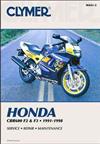
Softcover - 480 pages - Honda CBR600 1991 - 1998 Clymer Owners Service Repair Manual Covers the following models: CBR600F2 (1991-1994) CBR600F3 (1995-1998) CBR600SJR Smokin #39; Joe #39;s (1996) CBRSE Smokin #39; Joe #39;s (1998) CBR600F (U.K.)Contents: QUICK REFERENCE DATA GENERAL INFORMATIONManual organization / Notes cautions and warnings / Safety first / Service hints / Serial numbers / Parts replacement / Torque specifications / Fasteners / Lubricant / RTV Gasket sealant / Threadlocking compound / Expendable supplies / Basic hand tools / Test equipment / Precision measuring tools / Cleaning solvent / Other special tools / Mechanic #39;s tips / Ball bearing replacement / Oil seals / Riding safety TROUBLESHOOTINGOperating requirements / Troubleshooting instructions / Starting the engine / Emergency troubleshooting / Engine performance / Engine noises / Clutch/ Gearshift linkage / Transmission / Electrical troubleshooting / Test equipment / Basic test procedures / Electrical problems / Charging system / Ignition system troubleshooting / Starting system / Carburetor troubleshooting / Excessive vibration / Brake problems PERIO
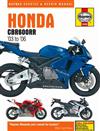
Hardcover - 344 pages - Honda CBR600RR 2003 - 2006 Haynes Owners Service Repair Manual Covers the following Models: CBR600RR-3 599cc 2003 CBR600RR-4 599cc 2004 CBR600RR-5 599cc 2005 CBR600RR-6 599cc 2006Contents: Living With Your HONDA CBR600RR SPORTBIKE- Identification Numbers- Buying Spare Parts- Pre-Ride Checks- Engine Oil Level- Brake Fluid Levels- Tyres- Bike Specs Maintenance- Routine Maintenance And Servicing- Specifications- Lubricants And Fluids- Maintenance Schedule- Component Locations- Maintenance Procedures Repairs And Overhaul- Engine Clutch And Transmission- Fuel And Exhaust Systems- Ignition System- Frame And Suspension- Brakes Wheels And Final Drive- Fairing And Bodywork- Electrical System- Wiring Diagrams Reference- Tools And Workshop Tips- Security- Storage- Troubleshooting
The CBR125 was introduced in 2004 by Honda to fill out a space when you look at the 125 cc marketplace left because of the stopped Honda NSR125. Its run on a liquid-cooled four-stroke, two-valve SOHC, single-cylinder 124.7 cc system with a claimed power score of 10 kW.
2004 to 2006
The systems created over these ages look like the CBR600F4i and use a carburetor inside gasoline program.
The Repsol colors system had been introduced in 2005 and remained for the appropriate year only because the CBR125RS5/6.
Exemplory case of the 2004-2006 CBR125R, manufactured in mid-2006.
2007 to 2010
In 2007, the CBR125R got some biggest changes including fuel injection.
The 2007 model obtained new front fairings to resemble the look of the CBR600RR as well as colour changes into the move supply and front forks which are today black.
Engine adjustment included PGM-FI: electric fuel injections, IACV, which works utilizing the FI program, and HECS3 air sensor to adhere to EURO-3 laws.
The Honda CBR250 a number of motorbikes had been from Honda between 1986 and 1996. It is a lightweight sport cycle with a six-speed gearbox and a 250 cc, four-cylinder, four-stroke motor capable of revving up to 19,000 rpm. Last year, Honda introduced the brand-new CBR250R with a much less powerful single-cylinder motor that revs to 10,500 rpm, built in Thailand and advertised worldwide.
Initially these bikes were best marketed newer in Japan, and soon after the CBR250RR is offered brand new in Australia. Nevertheless they are located in virtually any nation around the globe. In countries which may have a 250 cc student capacity restriction, the CBR250RR is one of the most powerful 4-stroke bikes a learner are permitted to drive. The CBR250RR possess six gears, and revs just under 9,000 rpm at 100 km/h. The engine makes use of gear-driven webcams which gives the cycle a uniquely recognizable characteristic 'whine' that differs with engine-speed.
The bicycle has actually a partly subjected aluminium frame and swing-arm. The suspension on the bicycle had been standard with non-adjustable front forks and a rear monoshock with modification for preload best.
The CBR250RR is known as the 'tri-colour' due to the fact that all the authoritative bicycles came for the reason that particular colour scheme. Besides the system restrictions, this design had a number of further variations to its predecessors. The bike had better low-beam headlights combined to a different relay that was automatically deactivated because of the start/crank option from the handlebar. This changed the pinout regarding the switchgear and kill-switch. The carburettor plastic boots were small regarding CBR250RR as compared to imports.
1986 CBR250 and
MC14 Twin forward disks, solitary front headlight, bikini fairings.
1987 CBR250R
MC17 Twin front disks, nevertheless solitary mind light, complete fairings.
1988 CBR250R
MC19 solitary larger front disk, smaller sequence, twin head lighting, fuel pump.
1989 CBR250R
MC19 Essentially exactly the same as the R, except today had a rate limiter that was ready at 185 km/h.
1990â1991 CBR250RR
MC22 a totally redesigned bike which had a fresh cast/pressed aluminum framework that offered a more intense cycling place, gull shaped move supply that was followed through the NSR250R, higher increasing tail, six talked throw aluminum tires and double front side 276 mm floating disk brake system. These changes led to a dry pounds of 142 kg. Really the only function which was used from the previous design CBR250s had been the MC14E system. This is slightly modified with a crankshaft which had 27.5 mm crankpins, up 0.5 mm through the earlier 27 mm size. The motor additionally made use of a completely new-set of VP carburetors which had smaller throats, paid off from 32 mm to 30.5 mm. These carburetors are given by vacuum pressure operated pump for gas shipping.
1992â1993 CBR250RR
MC22 simply the just like the RR except for brand-new paint jobs.
1994â1996 CBR250RR
MC22 Nonetheless nearly the same as the RR but restricted to making 40 hp considering alterations in Japanese legislation. The limitations are inside cylinder head, mind gasket and ignition product. Redline paid off to 18,500 rpm.
In October 2013 the longer-stroke Honda CBR300R had been established in the Asia worldwide bike Trade convention in Chongqing, with motor displacement increased from 249.6 to 286 cc responding on Kawasaki Ninja 300. Honda stated this new model has grown horsepower, from 26 to 30.5 bhp, and higher torque, from 17 to 20 lb·ft.
In February, 2014, Honda announced that manufacturing have been forced to late 2014.
The Honda CBR600F, referred to as 'Hurricane' in america marketplace, is a sports motorcycle produced by Honda from 1987 to 1990. In Austria and Mexico, an inferior version, the CBR500F is promoted. Last year, Honda introduced an all-new type of equivalent name. The initial CBR600F was Honda's first inline four-cylinder, totally faired athletics cycle. It had a liquid-cooled 85 hp DOHC 16-valve motor, and a six-speed transmission. The Honda Hurricane is launched once the latest type of sport cycle.
The CBR600F2
Honda CBR600F2 Honda CBR600F2.jpg
Also called PC25
Production 1991â1994
Predecessor CBR600F
Successor CBR600F3
Lessons athletics cycle
System 599 cc DOHC inline-four engine with 4 carburetors
Bore / stroke 65 mm à 45.2 mm
Compression proportion 11.5:1
Ignition type CDI, 2 coils, squandered spark
Transmission 12 dish wet clutch, 6-speed, O-Ring sealed chain
Frame kind metallic
Suspension system Front: 130 mm/43 mm backside: 110 mm Pro-Link
Brake system front side: 276 mm twin disk, 2 piston caliper Rear: 220 mm single disk, 1 piston caliper
Tires Front: 120/60-17 Back: 160/60-17
Wheelbase 1,405 mm
Measurements L: 2,010 mm
W: 695 mm
Chair level 810 mm
Fuel capacity 16 l
Relevant Honda CBR600RR
The Honda CBR600 F2 had been a bike made by Honda from 1991 to 1994. It was launched to restore the CBR600 Hurricane, or F1, and had been considered certainly one of Honda's modern and innovative sport bikes with regards to was launched. Development of the 2nd generation CBR began in early 1989. Hurricane LPL Ishikawa would lead the introduction of the new bicycle, understood internally as MV9, but that was also referred to as the F2, an alphanumeric that would being its formal name: CBR600F2.
The F2's developing began with meetings to discuss ideas and sketches when it comes to brand new bike. A few months later on, an F2 prototype had been produced. Painted black colored, the meaner-looking bicycle is quicker and sleeker hunting versus most blocky first generation bicycle. When tested, the F2 information were dazzling. The bike hit a balance that hardly any other bike at that time could attain. Couple of motorbikes in the 1990s had the performance potential associated with F2, while the design remains widely ridden on roads and racetracks throughout the world.
1994 Honda CBR600F2, with aftermarket chair, fatigue and windscreen
CBR600F3
Honda CBR600F3 Cbr600f3.jpg
Production 1995â1998
Forerunner CBR600F2
Successor CBR600F4
Course Sport bicycle
Motor 599 cc liquid-cooled in-line four
Bore / stroke 65.0 mm à 45.2 mm
Torque
43.7 lb·ft @ 10,000 rpm
42.8 lb·ft @ 8,250 rpm
Transmission Close proportion six-speed, string drive
Rake, path 25.2°, 94.0 mm
Wheelbase 1,400 mm
Proportions L: 2,055 mm
W: 685 mm
Seat level 810 mm
Weight
202 kg
210 kg
206 kg
Fuel capability 17 litres; 3.7 imperial gallons
Related Honda CBR600RR
The CBR600F3 had been the 3rd generation regarding the CBR600F series. It replaced the F2, and ended up being created from 1995 to 1998. They had a modified engine, ram-air intake and cartridge forks. The 1997 and 1998 models additionally came with a deeper oils pan, sleeker end fairings, chair and tail light, and a revised system head netting about a 5 hp build over 95/96 brands. The CDI and ram-air system had been furthermore revised to permitted for smoother throttle bend across 95/96 products, which could sometimes become jerky. The final made 1998 models was included with another revised motor mind which triggered a small energy build. In 1999, it had been replaced by the CBR600 F4.
In 1996 and 1998 the CBR600F3 was also offered in "Smokin' Joe's reproduction" models in the USA, Canada and Australia.
Cycle world-tested the F3's speed from 0 to 60 kilometers per hour at 2.8 moments and 0 to 1â4 mile at 10.9 moments at 125.28 miles per hour. Bike customer Development taped a 0 to 60 mph period of 3.36 seconds and a 1â4 mile period of 11.03 seconds at 124.06 miles per hour
CBR600F3 becoming disassembled
CBR600F4
Honda CBR600F4 Cbr600f4.jpg
Production 1999â2000
Predecessor CBR600F3
Successor CBR600F4i
Course super athletics
Motor 599 cc Straight-4
Transmission
6-speed, chain drive
electric beginner
Wheelbase 1,395 mm
Chair level 810 mm
Fat 170.0 kg
Related Honda CBR600RR
The Honda CBR600F4 had been a hobby bicycle from Honda between 1999 and 2000. It was the past associated with CBR600 variety of Honda sportbikes to-be carbureted.
The words, "specialized in Super Evaluators Dirk Vandenberg and Josef Boyd", are embossed in lifted letters within the Honda CBR600F4's upper fairing. This commitment is made because two of Honda R&D's elder item developers are killed during the final testing for this model.
CBR600F4i
Honda CBR600F4i Cbr600f 2004.jpg
Production 2001â2006
Predecessor CBR600F4
Course athletics bicycle
System 599 cc DOHC four valves per cylinder water-cooled inline-four
Bore / stroke 67.0 mm à 42.5 mm
Compression ratio 12:1
Top speeds 156 mph
Energy 81 kW @ 12,500 rpm, 90.1 hp at rear wheel
Torque 63 N·m @ 10,000 rpm, 40.2 lb·ft at rear wheel
Ignition kind CDI
Transmission damp clutch, 6-speed, chain drive
Framework means Aluminum twin-spar, box-section
Rake, path 24.0°, 96 mm
Wheelbase 1,390 mm
Chair height 805 mm
Pounds 370 pound
440 pound
Fuel ability 4.8 United States gallons
Gas consumption 36.7 mpg-US
The Honda CBR600F4i is an activity cycle that has been made by Honda from 2001 to 2006.
Record
For the 2001 model year Honda introduced an enhanced form of the favorite CBR600F4 with objectives of becoming more competitive into the middleweight recreation bike lessons. The 370 lb F4i try a modified F4 with numerous system, chassis and bodywork adjustment.
The single largest changes besides the styling may be the inclusion of high-pressure programmed fuel injections â hence the design designation "F4i". In a number of nations, the bicycle is offered both in the "normal" and "athletics" variations, the game creating a two-part seat, no grab train with no primary stay. Fuel injections permits most precise fuel metering and delivery over a wider rpm number, while providing best throttle responses and decreasing emissions. The injectors live one per cylinder and make use of 38 mm throttle systems. Each injector has four nozzles, and collectively the injectors add up to five horse power over the F4.
Weight was also reduced. A corner wheel is made 400 grms less heavy, the cush drive 600 grms, and front wheel 300 grms. The wheel bearings have already been relocated outward, nearer to the hand pipes, and the rotor carriers relocated out nearer to the braking system calipers to lessen pounds and develop rigidity. Each caliper provider furthermore missing 100 grams. There is certainly extra bracing regarding the steering head for lots more response, best feedback and feeling through the front end. The suspension has also been tweaked with less high-speed damping and a little more low-speed damping. The wheelbase are five millimeters shorter than its predecessor, with a 5.9-percent escalation in overall rigidity.
Extra motor adjustment incorporate a lighter camshaft sprocket and enhanced valve springtime pressure which allow for greater revving. There are new piston bands that fall with less rubbing and increased interior system oil movement. Redline has become 14,200 rpm, 700 rpm higher than the earlier year's F4. To improve the bicycle's pulling effectiveness at higher rates, 5th and 6th gears are reduced slightly while the rear sprocket is increased from 45 teeth to 46. The oiling holes inside camshafts happen enlarged by 0.5 mm and piston ring rubbing is reduced to aid cooling at the higher rev roof. Spring pressures regarding intake and exhaust valves being increased to stay away from valve float. Additionally, these day there are two device springs regarding intake part instead of the solitary items that resides regarding exhaust part.
In 2003, Honda introduced the CBR600RR, a higher-performance, race-ready, super-sport middleweight, while continuing to produce the popular F4i which appealed to those prepared to lose slightly efficiency to achieve an even more comfortable driving place, including a motor setup better suitable for each day cycling. The F4i stayed available for three most ages before being stopped, using 2006 design being the last someone to be revealed. No biggest revisions are built in these final ages aside from color system adjustment.
Styling
The 2001 people F4i have a new subframe which increases the chair by five milimeters and a greater two-tier seat enables even more storage space room into the back storage space. This new tail product has actually less padding and an increased perch when it comes to traveler. The F4i's tail-light was modest with a new dual-bulb setup. The F4i have a new dash design with a sizable analog tachometer. The brand new LCD digital screen had a speedometer, odometer, clock, system temperature read-out, amber change light, and journey yards.
The F4i's brand-new bodywork holds an even more racy search and provides a 3percent decrease in drag. In addition it houses an innovative new dual headlight front cowl design which uses 40% better H7 bulbs compared to the older H4 light bulbs. The headlights are twin multi-reflector devices included in a one-piece flexiglass lens. The change stalks is reduced and mirrors are actually placed greater and nearer to the rider. The elimination of carburetors let for a slightly larger environment field and a bigger 4.8 United States gal gasoline tank with a delayed fuel level sensor to avoid false readings whenever cycle reaches an angle.
In 2004 Honda changed the black colored frame with one out of silver and a banana seat as a result of issues of comfort and distinguish the F4i from 600RR. This design is the same as the CBR600F1 and onwards which was offered in the UK from 2001.
Two British versions of F4i had been introduced in 2001. The CBR600F F1 and onwards had the banana style seat available on pre PGM FI bicycles as the CBR600F FS1/FS2 are marketed using two tier seat models, black structures and differing various other overall performance improvements as based in the people systems. The F recreation is discontinued upon the arrival of CBR600RR in 2003.
In 2001 and 2002, in recognition of Honda's relationship with MotoGP champion Valentino Rossi, and its particular 500th bike Grand Prix success, the CBR600F4i was also introduced in Europe and Australian Continent in two "Rossi Replica" models.
Brand new CBR600F 2011â
Red 2011 Honda CBR600F at the Tokyo Motor Show
2011 Honda CBR600F at Tokyo Motor program
In 2011, Honda introduced the latest CBR600F. It shares all of the the different parts of the naked CB600F 'Hornet', but wraps it in a multi-layered full fairing that reduces drag and shields the driver from windblast. In addition it keeps the same calm sitting position to minimise driver tiredness. The new CBR600F also shares the system associated with the very revised CB600F design that arrived on the scene in April 2007. This motor try a detuned type of what will come in the 2007 CBR600RR giving a maximum output energy of around 102 bhp at 12000RPM and 65Nm of Torque at 10500RPM.
The CBR600RR originated from and encouraged because of the Honda RC211V MotoGP cycle. The comparable looks of this CBR600RR and RC211V is intentional. Within the bicycle had been MotoGP technologies which were made available the very first time on a production bike, such as the device Pro-Link rear suspension and Dual Stage gas injections. Both were taken directly from Honda's MotoGP bicycle. The RR, or race reproduction, suffix ended up being put into focus on racing characteristics such as for instance a sophisticated braced swingarm, center-up fatigue program, plus intense operating position.
2003-2004 revision
The 2003 model carried over to 2004 theoretically unchanged, with only the extension of an oxygen sensor and new colors schemes.
2005-2006 revision
2006 CBR600RR
Product Pro-Link swingarm
In 2005, the CBR600RR obtained a significant revision with brand-new bodywork, fully flexible inverted front side forks, race-inspired disc brake system with radial-mounted four-piston calipers, and a completely new aluminum framework, swingarm and rear shock. The midrange energy was also increasing. These modifications along side additional refinements towards the engine and exhaust program all emerged together to bring CBR600RR's damp fat down by 10.0 kg, and dry weight by 4.1 kg aside from newer colors systems, the 2006 model had been unchanged through the 2005 model.
2007-2008 redesign
2007 CBR600RR during the Global bike program
On September 6, 2006, Honda revealed a new CBR600RR for the 2007 model season.
â The CBR600's more radical redesign because the introduction associated with the RR in 2003 try highlighted by another system, framework, and bodywork that results in an inferior, light, more-powerful CBR600RR with a class-leading power-to-weight proportion and unrivaled results. â
Fat was the principal focus regarding the redesign. The result is a 9.1 kg lowering of dry weight over the 2006 design, from a claimed 361 pound to 341 lb. Tested weights without gas were 182â182 kg.
In redecorating the CBR600RR for less heavy weight and enhanced performance, Honda's engineers going using engine. The new system was modest and lighter than their predecessor, the developers having used cautious positioning of most interior elements to reach significant reductions within the motor's size, circumference, and level, along with reducing pounds by 2 kg when compared to 2006 design's powerplant. Horse power increased to about 105 hp assessed in independent tests.
The frame had been light, slimmer, plus compact than that the 2006 CBR600RR. The frame was created making use of what Honda calls Fine Die-Cast technology, which allowed all of them to create a lighter framework without limiting power or rigidity. The maneuvering associated with newer cycle ended up being sharpened by its 22 mm faster wheelbase, plus by the fashion designer's give attention to rigid size centralization. Despite the faster wheelbase, the 2007 model's swingarm ended up being 5 mm longer than that of the 2006, authorized by the more compact proportions associated with new bike's system.
The suspension system associated with the 2007 design was transported over practically unchanged through the 2006 bicycle, with similar 41 mm inverted fork in the front, and Honda's product Pro-Link back suspension configuration damping the rear wheel. The newest three-spoke cast aluminum wheels are also lighter than those on the 2006 bicycle, which more contributed to the improved overall performance regarding the suspension system. The brake system featured dual radial-mount four-piston calipers and twin 310 mm discs at the front, and a single-piston caliper and a 220 mm disk on rear. Concealed underneath the steering head was an updated form of the Honda Electronic Steering Damper system, that was additionally available on the CBR1000RR.
Small, sharper-edged new front top fairing was ruled because of the big central ram-air duct which given the airbox through an orifice in the steering mind element of the framework and had been separated from side associated with the fairing by a big gap which Honda stated is for air control functions. The tail-section ended up being similarly smaller and sharper-edged, operating atop a heavily restyled under-seat muffler.
The motorcycle held more than with just shade system modifications for 2008 model 12 months.
Blended abdominal muscles model
On June 9, 2008, Honda unveiled a CBR600RR prototype that showcased a new stopping program labeled as Combined ABS which integrated combined stopping, anti-lock braking, and brake-by-wire systems. Blended ABS used a computer control device to guarantee the proper stability of front and rear brake use also monitored once the abdominal muscles should engage. The device had been built to become because unobtrusive that you can by delaying the engagement associated with ABS through to the final possible second. Combined abdominal muscles wasn't made available on the production 2008 CBR600RR.
2009-2012 modification
2010 Honda CBR600RR
2009 Honda CBR600RR ABS sensor
On September 5, 2008, Honda introduced a revised CBR600RR for the 2009 model season. Combined ABS became offered as an alternative. More modifications included revisions towards the motor such modifications to their pistons, cylinder mind and fatigue that Honda claims increases torque delivery between 8,000-12,000 rpm with a 3.5% escalation in torque at 10,000 rpm. The CBR600RRâs system additionally obtained an innovative new highest weight device lifter and a popup device system passed down through the CBR1000RR. Included also are enhanced fairings that enhance stability and lower sound emission level, and brand-new colors schemes which were built to entice a wider range of cyclists. Although all of these changes included the choice of some components, the entire pounds for the 2009 CBR600RR remained just like the 2008 model. It was accomplished through body weight discount within the system, exhaust, and the framework.
The CBR600RR held more than with just shade scheme modifications for the 2010, 2011 and 2012 design ages.
2013-2015 modification
The 2013 CBR600RR includes brand-new 12-spoke rims, revised ECU setup, and a fine-tuned ram-air program to improve torque. Moreover it gets a fresh Showa âBig Piston Fork" and retuned back shock in a brand new bodywork. Three color systems are available, including one out of the MotoGPâs Repsol livery. Another two tend to be purple and tricolor. Another significant changes is the recently designed forward end, rendering it be noticed from prior models.
Competitors
2007
When it comes to 2007 model seasons, the CBR600RR competed using Ducati 749, a completely redesigned Kawasaki Ninja ZX-6R, the Suzuki GSX-R600, the success Daytona 675, and the Yamaha YZF-R6. Shootout reviews by motorcycle mags regularly awarded the CBR600RR beginning in very sport class. Significant print and on the web writers praise the cycle for the powerful motor and class-leading lightweight.
2008
For 2008 model seasons, the CBR600RR carried on to take on the Kawasaki Ninja ZX-6R, a modified Suzuki GSX-R600, the victory Daytona 675, and a Yamaha R6. Despite no technical modifications through the 2007 design, the CBR600RR continuing to winnings middleweight shootouts like athletics Rider's middle fat shootout, Motorcycle-USA's middleweight comparison, and bike.com's middleweight contrast.